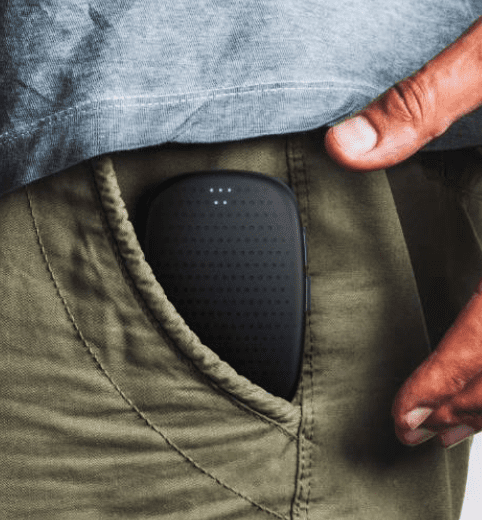San Francisco-based Whisper has announced the first upgrade to its Whisper Hearing System. As the first of many, this upgrade marks the beginning of a long-term series of planned improvements in sound processing and new features to Whisper—all without the need for existing users to purchase a new hearing aid.
Released in October 2020, the Whisper Hearing System is made up of three components: 1) a set of receiver-in-the-canal (RIC) hearing aids; 2) the “Whisper Brain” which is a small separate device that runs an AI-driven Sound Separation Engine to optimize sound in real-time and enables connectivity to iPhones, and 3) the Whisper app interface for consumers. Because the system includes the Brain, it reportedly features enhanced processing power and computational abilities, as well as easy upgradability over the lifetime of the device. Whisper uses a subscription-based payment model for consumers, so the product upgrades can be made frequently without replacing the hardware each time. It is the first new major hearing aid brand launched specifically for the professional dispensing market in over 15 years.
With its initial roll-out, Whisper partnered with an exclusive network of local practices across the country to ensure consumers receive customized care. It is now gradually expanding this outreach.
“We’re trying to be really practical with hearing care professionals,” Whisper Co-founder and President Andrew Song told Hearing Review. “We know they’re not going to dive in and recommend a product widely to patients [until they’re convinced of its performance]. We also made a product that is specifically designed to be upgraded over time. We planned on delivering on that promise fairly quickly when we launched in mid-October, and now we’re delivering on that promise.”
According to Whisper, the company used tens of thousands of hours of audio information to improve its AI-based Sound Separation Engine. As a result, consumers may be able to hear voices more clearly, with over 40% of people surveyed in Whisper’s Research Center reporting that they are hearing voices better after receiving this software upgrade.
“It’s really amazing because virtually everything in this update has come from what you might think of as ‘insider’ insights from hearing care professionals and patients,” says Song. “As a result, almost every part of our audio system has been improved in some way—whether it’s the AI, the compression or feedback management system, and more. So, with this upgrade, we hope to show what’s really possible with this type of system.”
Song explains the Sound Separation Engine is driven by an AI model, which receives the sound, makes sense of the existing sound patterns, and determines how the signals can be better processed for the prescribed hearing loss. The new upgrade includes two improvements to this engine: 1) The AI sound processing model was developed further based on tens-of-thousands of hours of user data—real-life sounds that people experience in a number of different listening environments, and 2) Tweaking of the actual technical foundation on which the Whisper AI Brain processing resides to ensure that it possesses the appropriate architecture for this and subsequent upgrades.
In addition to improving the underlying artificial intelligence, Whisper improved how hearing care professionals adjust the Whisper Hearing System to best support their patients’ unique hearing profiles with an upgraded compression system. The new upgrade also contains noise-reduction algorithm and sound quality processing improvements.
“We have a bunch more [upgrades] planned this year, and we don’t plan on stopping,” says Song. “I think that’s the big picture that hearing care professionals in particular will start to realize. It’s not like we’re saying, ‘Okay, we made one upgrade, and the hearing aid sounds better now.’ That’s really not the point. This is going to continue. In fact, this isn’t even about the patient who bought our hearing aid back in October…Instead, let’s think about a patient who 2 years ago bought a hearing aid that can’t be upgraded, and think about [the improvements] they’d be missing out on now, and what they’ll be missing out on 2 years from today.”
When HR asked who was the largest influence in the new product update—hearing care professionals or the data and input from patients—Song said both were crucial. “I don’t think you can do a great job with just one or the other. In many ways, consumers can tell you what they’d like improved and describe what hearing situations they’re in, but the hearing care professionals can really add the ‘why’ to that—which is tremendously important. And that can start anywhere from why they [specified] the hearing aid for that particular patient’s needs in the clinical setting, all the way to the follow-up appointments and adjustments, and why the patients liked or didn’t like a particular feature. As with any health product or medical device, it has to work with and for that particular person…So we’ve been seeking a wide range of feedback, and that’s what our team has been doing: taking all those data points and turning it into something useful for people—whether it’s better fitting guidance, stronger audio processing offerings, upgrading the AI, as well as all the other improvements.
The company points out that, with Whisper, software upgrades are always free. They are included in Whisper’s comprehensive monthly plan that not only includes the upgrades, but also ongoing care from a local hearing care professional, a lease of the Whisper Hearing System, and a 3-year warranty that covers the system itself and loss and damage. There is a special introductory offer of $139/month (regularly $179/month) for a 3-year term.
For more information, visit: https://whisper.ai/professionals.







